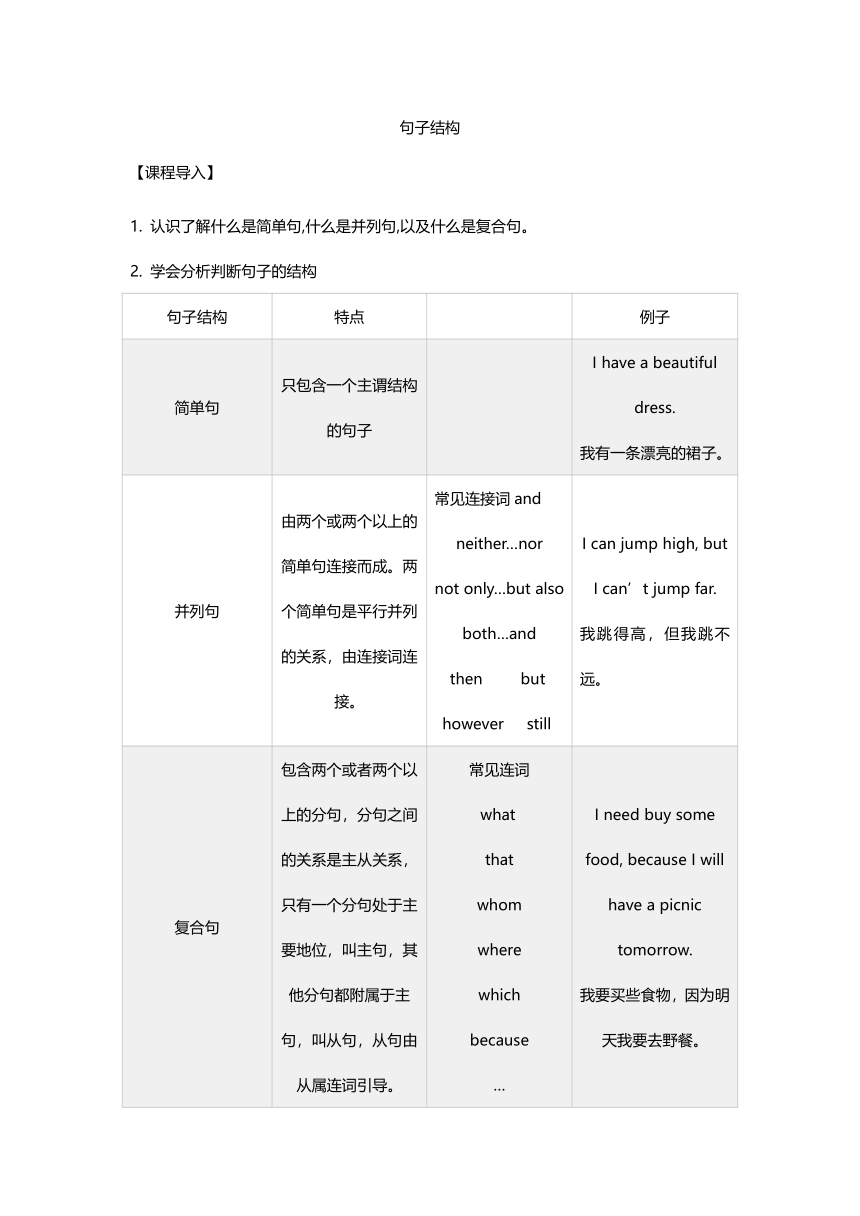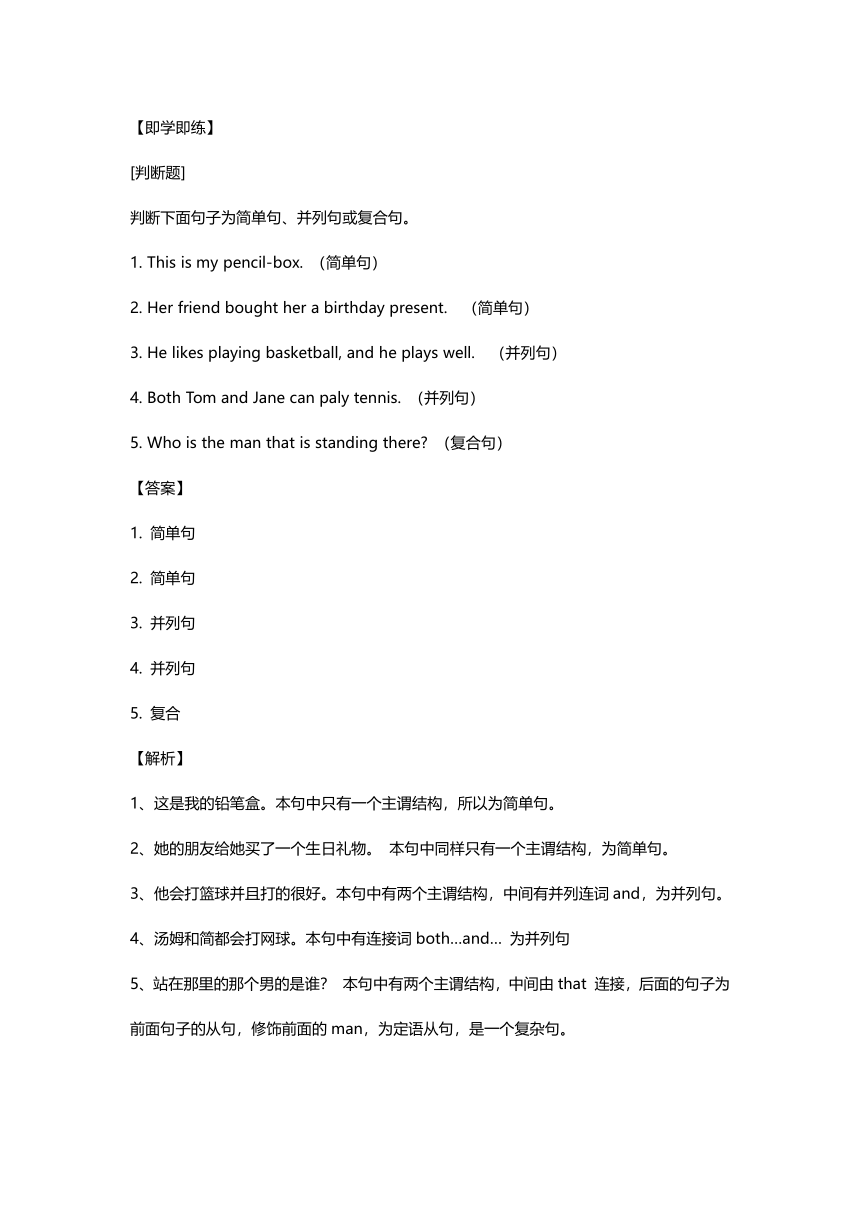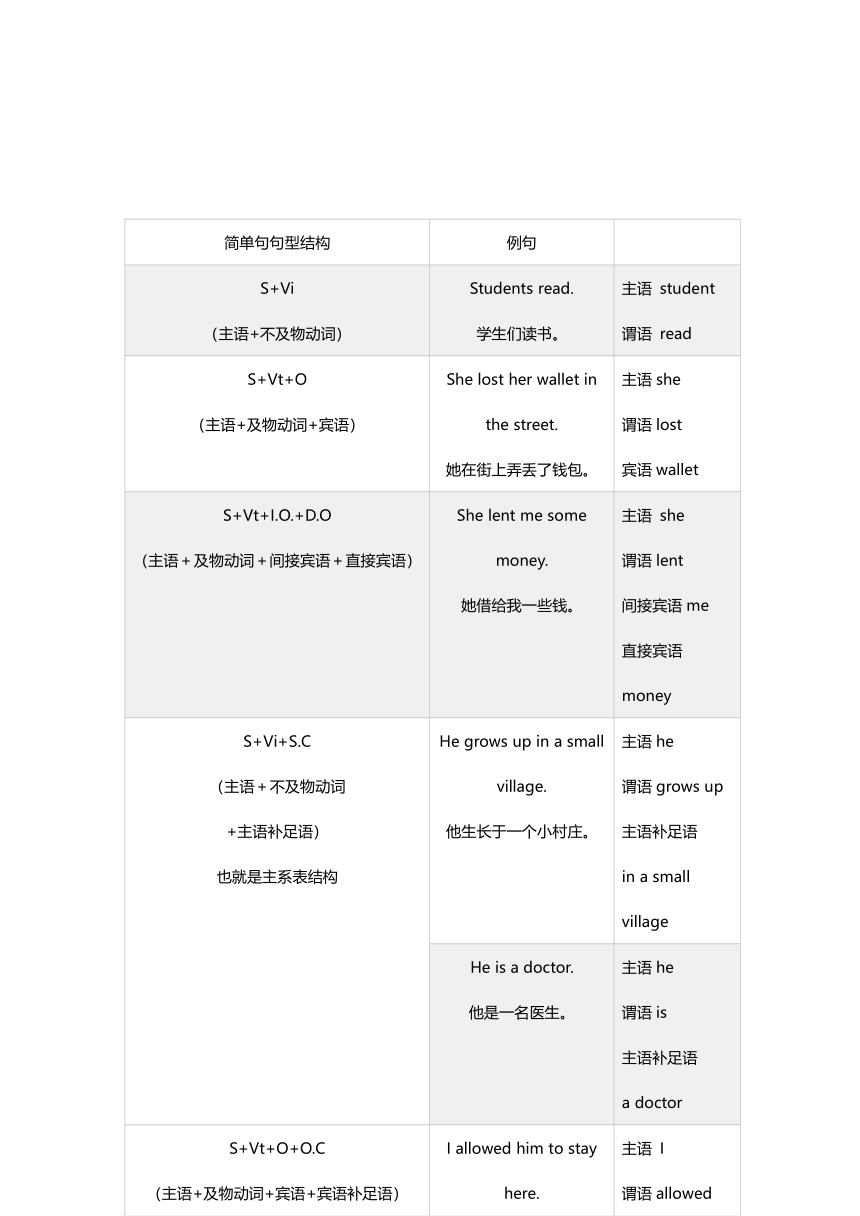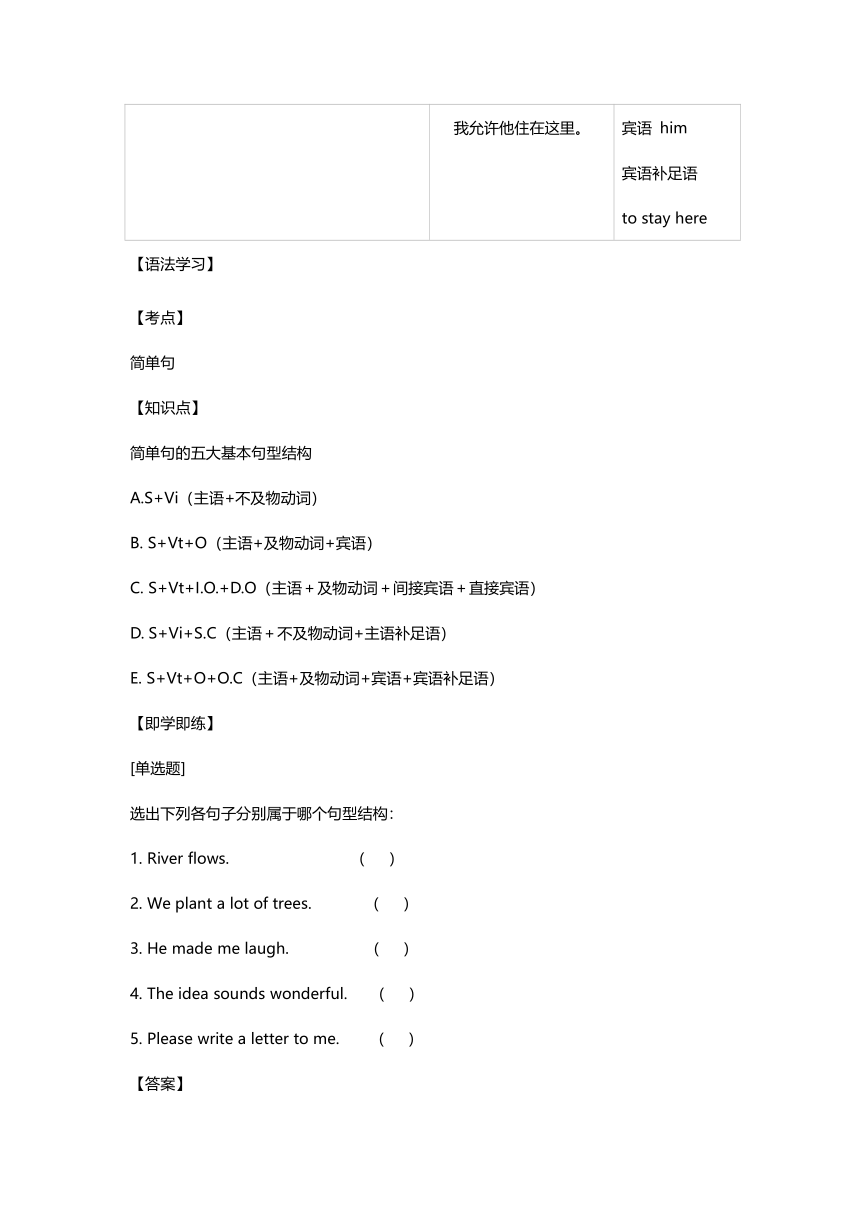初中语法知识点_lesson32-34句子结构-简单句-并列句-复合句
文档属性
| 名称 | 初中语法知识点_lesson32-34句子结构-简单句-并列句-复合句 |  | |
| 格式 | docx | ||
| 文件大小 | 22.8KB | ||
| 资源类型 | 试卷 | ||
| 版本资源 | 通用版 | ||
| 科目 | 英语 | ||
| 更新时间 | 2021-08-18 14:06:06 | ||
图片预览




文档简介
句子结构
【课程导入】
1. 认识了解什么是简单句,什么是并列句,以及什么是复合句。
2. 学会分析判断句子的结构
句子结构
特点
例子
简单句
只包含一个主谓结构的句子
I have a beautiful dress.
我有一条漂亮的裙子。
并列句
由两个或两个以上的简单句连接而成。两个简单句是平行并列的关系,由连接词连接。
常见连接词and
neither…nor
not only…but also both…and
then but
however still
I can jump high, but I can’t jump far.
我跳得高,但我跳不远。
复合句
包含两个或者两个以上的分句,分句之间的关系是主从关系,只有一个分句处于主要地位,叫主句,其他分句都附属于主句,叫从句,从句由从属连词引导。
常见连词
what
that
whom
where
which
because
…
I need buy some food, because I will have a picnic tomorrow.
我要买些食物,因为明天我要去野餐。
【即学即练】
[判断题]
判断下面句子为简单句、并列句或复合句。
1. This is my pencil-box. (简单句)
2. Her friend bought her a birthday present. (简单句)
3. He likes playing basketball, and he plays well. (并列句)
4. Both Tom and Jane can paly tennis. (并列句)
5. Who is the man that is standing there? (复合句)
【答案】
1. 简单句
2. 简单句
3. 并列句
4. 并列句
5. 复合
【解析】
1、这是我的铅笔盒。本句中只有一个主谓结构,所以为简单句。
2、她的朋友给她买了一个生日礼物。 本句中同样只有一个主谓结构,为简单句。
3、他会打篮球并且打的很好。本句中有两个主谓结构,中间有并列连词and,为并列句。
4、汤姆和简都会打网球。本句中有连接词both…and… 为并列句
5、站在那里的那个男的是谁? 本句中有两个主谓结构,中间由that 连接,后面的句子为前面句子的从句,修饰前面的man,为定语从句,是一个复杂句。
简单句句型结构
例句
S+Vi
(主语+不及物动词)
Students read.
学生们读书。
主语 student
谓语 read
S+Vt+O
(主语+及物动词+宾语)
She lost her wallet in the street.
她在街上弄丢了钱包。
主语she
谓语lost
宾语wallet
S+Vt+I.O.+D.O
(主语+及物动词+间接宾语+直接宾语)
She lent me some money.
她借给我一些钱。
主语 she
谓语lent
间接宾语me
直接宾语money
S+Vi+S.C
(主语+不及物动词
+主语补足语)
也就是主系表结构
He grows up in a small village.
他生长于一个小村庄。
主语he
谓语grows up
主语补足语
in a small village
He is a doctor.
他是一名医生。
主语he
谓语is
主语补足语
a doctor
S+Vt+O+O.C
(主语+及物动词+宾语+宾语补足语)
I allowed him to stay here.
我允许他住在这里。
主语 I
谓语allowed
宾语 him
宾语补足语
to stay here
【语法学习】
【考点】
简单句
【知识点】
简单句的五大基本句型结构
A.S+Vi(主语+不及物动词)
B. S+Vt+O(主语+及物动词+宾语)
C. S+Vt+I.O.+D.O(主语+及物动词+间接宾语+直接宾语)
D. S+Vi+S.C(主语+不及物动词+主语补足语)
E. S+Vt+O+O.C(主语+及物动词+宾语+宾语补足语)
【即学即练】
[单选题]
选出下列各句子分别属于哪个句型结构:
1. River flows. ( )
2. We plant a lot of trees. ( )
3. He made me laugh. ( )
4. The idea sounds wonderful. ( )
5. Please write a letter to me. ( )
【答案】
1. A
2. B
3. E
4. D
5. C
【解析】
1. 河流会流动。主语river+不及物动词flow
2. 我们种了很多树。 主语we +及物动词plant+宾语a lot of trees
3. 他把我逗乐了。 主语he+及物动词made+宾语me+宾语补足语laugh
4. 这个主意听起来很棒。 主语the idea+系动词sounds+主语补足语wonderful
5. 请给我写信。主语you(省略)+及物动词write+间接宾语a letter+直接宾语me
【考点】
并列句
【知识点】
并列句的几种类型
一、联合关系
常用的连词有 and( 同,和 ), when(=and just at this time 就在这时,然后 ), not only…but (also)…( 不仅……而且…… ), neither…nor… (既不……也不……)等。
He helps me and I help him. 他帮我,我帮他。
He not only gave us a lot of advice, but also helped us to study English. 他不仅给我们出很多建议并且还帮助我学英语。
I was just leaving when the telephone rang. 我正要离开,电话铃响了。
注: when 作这种用法时,主要用于
was/were doing sth. when sth./sb. did;
was/were about to do sth. when sth./sb. did;
was/were on the point of doing sth. when sth./sb. did
等句型中,表示“当某人或某物正在或正要做某事,就在这时突然又发生了另一事”。
【即学即练】
[单选题]
--We get knowledge( ) from books ( )from life.
--Yes, both are important.
A. either; or B. not only; but also C. neither; nor D. not; but
【答案】B
【解析】--我们不仅能从书本中获得知识也可以从生活中获得。-- 是的它们都很重要。
not only…but (also)…( 不仅……而且…… )
either...or( 不是……就是 )
neither…nor… (既不……也不……)
not; but(不是……而是)
根据答句所说两者都很重要可以确定应该选 not only;but also
二、选择关系
常用的连词有 or( 或者,否则 ), otherwise( 否则 ), or else( 否则 ), either...or( 不是……就是 ) 。如:
Hurry up, or (else) you’ll be late. 快点,否则就会迟到了。
Will he still be there or will he have gone away他那时还在那里还是可能已经走了?
You must go early, otherwise you will miss the bus. 你好得早点走,否则就赶不上公共汽车了。
Either Tom is coming or his sisters are. 不是汤姆就是她的姐妹们要来。
【即学即练】
[单选题]
--How do you like the two pairs of shoes?
--They don’t fit me well. They are ( ) too big ( ) too small.
A. not only; but also B. both; and C. neither; nor D. either; or
【答案】D
【解析】--你觉得这两双鞋怎么样?
--它们都不是很合适。 不是太大就是太小。
not only…but (also)…( 不仅……而且…… )
either...or( 不是……就是 )
neither…nor… (既不……也不……)
both…and (两者都…)
答语中说这两双鞋都不是很合适,不是大就是小,所以应选择 either or
三、转折关系
常用的连词有 but( 但是,可是,只是因为 ), while( 而、却 ), yet( 可是 ) 等。
I like tea while she likes coffee. 我喜欢喝茶而她喜欢喝咖啡。
She said she would be late, yet she arrived on time. 她说她会迟到,但她却准时到达了。
She looks very young, but she is already in her 30’s. 她看上去很年轻, 可是她已三十多岁了。
此处,还有副词 still( 仍然), however( 然而 ) 也表示转折关系。
He is good-natured; still I don't like him. 他脾气很好 , 可是我还是不喜欢他。
The book is expensive; however, it's worth it. 这本书很贵;却很值。
注意: but, while 不与 although 连用,但 yet, still 可与 although 连用。
Although she felt ill, she still went to work. 她虽然感觉不舒服,但她仍然去上班。
【即学即练】
[单选题]
The little boy is very young ( )he can look after himself well.
A. so B. but C. if D. or
【答案】B
【解析】 这个小男孩虽然很年幼但是他可以自己照顾好自己。But表示转折,so表示因此,if表示如果,or表示或者。
四、因果关系
常用的连词有 for (因为)和 so (所以,因此)等。如:
I am thirsty, for it is hot. 我口渴,因为天气太热。
The manager was ill so I went in her place. 经理病了所以我代她去。
注意: so 不与 because 连用
【即学即练】
[单选题]
Bill put his hands behind his back, ( )nobody could see his hands.
A. so B. but C. and D. or
【答案】A
【解析】比尔把他的手背在了后面,因此没人可以看到他的手。So表示因此,but表示转折,and 表示和,同;or表示或者,否则。
【考点】
复合句
【知识点】
复合句:包含两个或者两个以上的分句,分句之间的关系是主从关系,只有一个分句处于主要地位,叫主句,其他分句都附属于主句,叫从句,从句由从属连词引导。根据其在整个句子中的语法功能可分为三种,即名词性从句、定语从句和状语从句。它们在句子中充当主语、宾语、表语、定语、同位语、状语等。
That’s exactly what I mean. 我要说的正是这个意思。 (表语从句)
What he saw and heard on his trip gave him a very deep impression. (主语从句)
这次旅行中的所见所闻给他留下了深刻的印象。
Where is the book that I read this morning? (定语从句)我今天早上读的书在哪里?
【课程导入】
1. 认识了解什么是简单句,什么是并列句,以及什么是复合句。
2. 学会分析判断句子的结构
句子结构
特点
例子
简单句
只包含一个主谓结构的句子
I have a beautiful dress.
我有一条漂亮的裙子。
并列句
由两个或两个以上的简单句连接而成。两个简单句是平行并列的关系,由连接词连接。
常见连接词and
neither…nor
not only…but also both…and
then but
however still
I can jump high, but I can’t jump far.
我跳得高,但我跳不远。
复合句
包含两个或者两个以上的分句,分句之间的关系是主从关系,只有一个分句处于主要地位,叫主句,其他分句都附属于主句,叫从句,从句由从属连词引导。
常见连词
what
that
whom
where
which
because
…
I need buy some food, because I will have a picnic tomorrow.
我要买些食物,因为明天我要去野餐。
【即学即练】
[判断题]
判断下面句子为简单句、并列句或复合句。
1. This is my pencil-box. (简单句)
2. Her friend bought her a birthday present. (简单句)
3. He likes playing basketball, and he plays well. (并列句)
4. Both Tom and Jane can paly tennis. (并列句)
5. Who is the man that is standing there? (复合句)
【答案】
1. 简单句
2. 简单句
3. 并列句
4. 并列句
5. 复合
【解析】
1、这是我的铅笔盒。本句中只有一个主谓结构,所以为简单句。
2、她的朋友给她买了一个生日礼物。 本句中同样只有一个主谓结构,为简单句。
3、他会打篮球并且打的很好。本句中有两个主谓结构,中间有并列连词and,为并列句。
4、汤姆和简都会打网球。本句中有连接词both…and… 为并列句
5、站在那里的那个男的是谁? 本句中有两个主谓结构,中间由that 连接,后面的句子为前面句子的从句,修饰前面的man,为定语从句,是一个复杂句。
简单句句型结构
例句
S+Vi
(主语+不及物动词)
Students read.
学生们读书。
主语 student
谓语 read
S+Vt+O
(主语+及物动词+宾语)
She lost her wallet in the street.
她在街上弄丢了钱包。
主语she
谓语lost
宾语wallet
S+Vt+I.O.+D.O
(主语+及物动词+间接宾语+直接宾语)
She lent me some money.
她借给我一些钱。
主语 she
谓语lent
间接宾语me
直接宾语money
S+Vi+S.C
(主语+不及物动词
+主语补足语)
也就是主系表结构
He grows up in a small village.
他生长于一个小村庄。
主语he
谓语grows up
主语补足语
in a small village
He is a doctor.
他是一名医生。
主语he
谓语is
主语补足语
a doctor
S+Vt+O+O.C
(主语+及物动词+宾语+宾语补足语)
I allowed him to stay here.
我允许他住在这里。
主语 I
谓语allowed
宾语 him
宾语补足语
to stay here
【语法学习】
【考点】
简单句
【知识点】
简单句的五大基本句型结构
A.S+Vi(主语+不及物动词)
B. S+Vt+O(主语+及物动词+宾语)
C. S+Vt+I.O.+D.O(主语+及物动词+间接宾语+直接宾语)
D. S+Vi+S.C(主语+不及物动词+主语补足语)
E. S+Vt+O+O.C(主语+及物动词+宾语+宾语补足语)
【即学即练】
[单选题]
选出下列各句子分别属于哪个句型结构:
1. River flows. ( )
2. We plant a lot of trees. ( )
3. He made me laugh. ( )
4. The idea sounds wonderful. ( )
5. Please write a letter to me. ( )
【答案】
1. A
2. B
3. E
4. D
5. C
【解析】
1. 河流会流动。主语river+不及物动词flow
2. 我们种了很多树。 主语we +及物动词plant+宾语a lot of trees
3. 他把我逗乐了。 主语he+及物动词made+宾语me+宾语补足语laugh
4. 这个主意听起来很棒。 主语the idea+系动词sounds+主语补足语wonderful
5. 请给我写信。主语you(省略)+及物动词write+间接宾语a letter+直接宾语me
【考点】
并列句
【知识点】
并列句的几种类型
一、联合关系
常用的连词有 and( 同,和 ), when(=and just at this time 就在这时,然后 ), not only…but (also)…( 不仅……而且…… ), neither…nor… (既不……也不……)等。
He helps me and I help him. 他帮我,我帮他。
He not only gave us a lot of advice, but also helped us to study English. 他不仅给我们出很多建议并且还帮助我学英语。
I was just leaving when the telephone rang. 我正要离开,电话铃响了。
注: when 作这种用法时,主要用于
was/were doing sth. when sth./sb. did;
was/were about to do sth. when sth./sb. did;
was/were on the point of doing sth. when sth./sb. did
等句型中,表示“当某人或某物正在或正要做某事,就在这时突然又发生了另一事”。
【即学即练】
[单选题]
--We get knowledge( ) from books ( )from life.
--Yes, both are important.
A. either; or B. not only; but also C. neither; nor D. not; but
【答案】B
【解析】--我们不仅能从书本中获得知识也可以从生活中获得。-- 是的它们都很重要。
not only…but (also)…( 不仅……而且…… )
either...or( 不是……就是 )
neither…nor… (既不……也不……)
not; but(不是……而是)
根据答句所说两者都很重要可以确定应该选 not only;but also
二、选择关系
常用的连词有 or( 或者,否则 ), otherwise( 否则 ), or else( 否则 ), either...or( 不是……就是 ) 。如:
Hurry up, or (else) you’ll be late. 快点,否则就会迟到了。
Will he still be there or will he have gone away他那时还在那里还是可能已经走了?
You must go early, otherwise you will miss the bus. 你好得早点走,否则就赶不上公共汽车了。
Either Tom is coming or his sisters are. 不是汤姆就是她的姐妹们要来。
【即学即练】
[单选题]
--How do you like the two pairs of shoes?
--They don’t fit me well. They are ( ) too big ( ) too small.
A. not only; but also B. both; and C. neither; nor D. either; or
【答案】D
【解析】--你觉得这两双鞋怎么样?
--它们都不是很合适。 不是太大就是太小。
not only…but (also)…( 不仅……而且…… )
either...or( 不是……就是 )
neither…nor… (既不……也不……)
both…and (两者都…)
答语中说这两双鞋都不是很合适,不是大就是小,所以应选择 either or
三、转折关系
常用的连词有 but( 但是,可是,只是因为 ), while( 而、却 ), yet( 可是 ) 等。
I like tea while she likes coffee. 我喜欢喝茶而她喜欢喝咖啡。
She said she would be late, yet she arrived on time. 她说她会迟到,但她却准时到达了。
She looks very young, but she is already in her 30’s. 她看上去很年轻, 可是她已三十多岁了。
此处,还有副词 still( 仍然), however( 然而 ) 也表示转折关系。
He is good-natured; still I don't like him. 他脾气很好 , 可是我还是不喜欢他。
The book is expensive; however, it's worth it. 这本书很贵;却很值。
注意: but, while 不与 although 连用,但 yet, still 可与 although 连用。
Although she felt ill, she still went to work. 她虽然感觉不舒服,但她仍然去上班。
【即学即练】
[单选题]
The little boy is very young ( )he can look after himself well.
A. so B. but C. if D. or
【答案】B
【解析】 这个小男孩虽然很年幼但是他可以自己照顾好自己。But表示转折,so表示因此,if表示如果,or表示或者。
四、因果关系
常用的连词有 for (因为)和 so (所以,因此)等。如:
I am thirsty, for it is hot. 我口渴,因为天气太热。
The manager was ill so I went in her place. 经理病了所以我代她去。
注意: so 不与 because 连用
【即学即练】
[单选题]
Bill put his hands behind his back, ( )nobody could see his hands.
A. so B. but C. and D. or
【答案】A
【解析】比尔把他的手背在了后面,因此没人可以看到他的手。So表示因此,but表示转折,and 表示和,同;or表示或者,否则。
【考点】
复合句
【知识点】
复合句:包含两个或者两个以上的分句,分句之间的关系是主从关系,只有一个分句处于主要地位,叫主句,其他分句都附属于主句,叫从句,从句由从属连词引导。根据其在整个句子中的语法功能可分为三种,即名词性从句、定语从句和状语从句。它们在句子中充当主语、宾语、表语、定语、同位语、状语等。
That’s exactly what I mean. 我要说的正是这个意思。 (表语从句)
What he saw and heard on his trip gave him a very deep impression. (主语从句)
这次旅行中的所见所闻给他留下了深刻的印象。
Where is the book that I read this morning? (定语从句)我今天早上读的书在哪里?
同课章节目录
- 词法
- 名词
- 动词和动词短语
- 动词语态
- 动词时态
- 助动词和情态动词
- 非谓语动词
- 冠词
- 代词
- 数词和量词
- 形容词副词及其比较等级
- 介词和介词短语
- 连词和感叹词
- 构词法
- 相似、相近词比较
- 句法
- 陈述句
- 一般疑问句和否定疑问句
- 特殊疑问句及选择疑问句
- 反意疑问句
- 存在句(There be句型)
- 宾语从句
- 定语从句
- 状语从句
- 主谓一致问题
- 简单句
- 并列句
- 复合句
- 主谓一致
- 主、表语从句
- 名词性从句
- 直接引语和间接引语
- 虚拟语气
- 感叹句
- 强调句
- 倒装句
- 祈使句
- 句子的成分
- 句子的分类
- 题型专区
- 单项选择部分
- 易错题
- 完形填空
- 阅读理解
- 词汇练习
- 听说训练
- 句型转换
- 补全对话
- 短文改错
- 翻译
- 书面表达
- 任务型阅读
- 语法填空
- 其他资料
